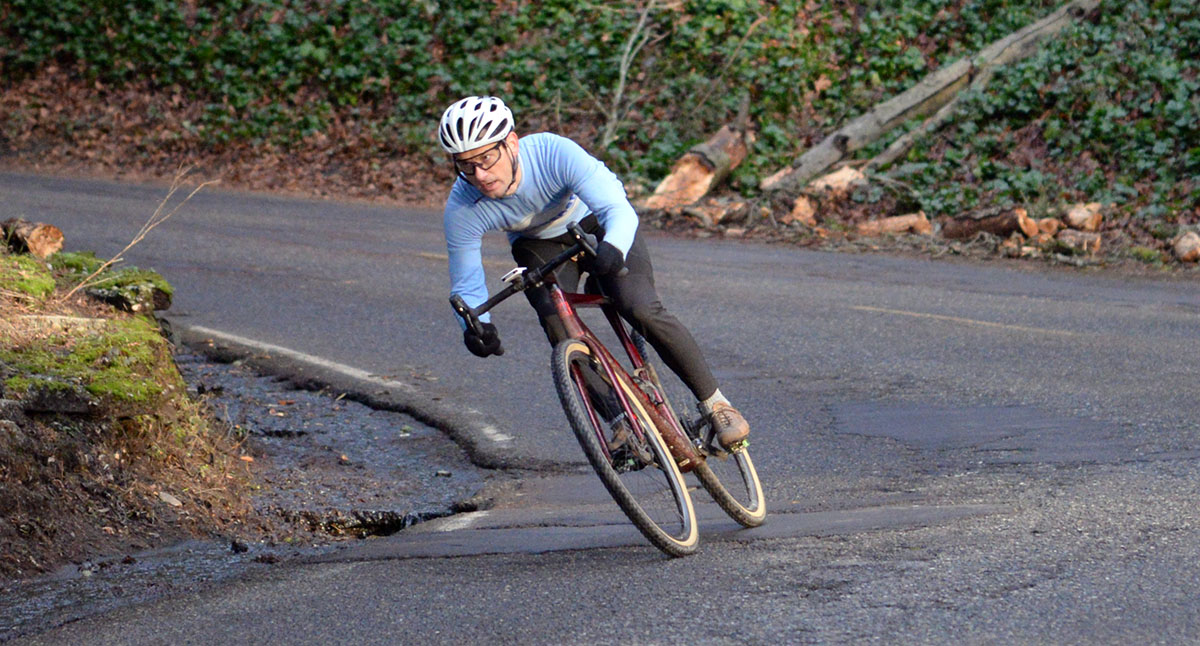Why We Don’t Like Side Knobs
The standard way to make tires for gravel racing is simple: Use a smooth center with side knobs that are supposed to help with traction in corners. The idea is that you roll on the smooth part most of the time, and you get added traction when you lean into a corner and need more grip. At first sight, it makes sense.
Why doesn’t make Rene Herse a semi-slick tire with side knobs? The simple truth is that side knobs don’t help with cornering traction. Most of the time, they don’t hurt, either, but there are good reasons not to put side knobs on your tires.

Gerard Vroomen, co-founder of Cervelo and Open, explained this years ago:
“In general, we find side knobs superfluous on gravel tires. If you’re hanging at such an acute angle, you’re about to hit the ground anyway. Even worse, the only terrain where you could achieve such an angle without falling is on asphalt, and the last thing you want is side knobs hitting the road instead of smoother rubber.”

Gerard points out a simple truth: You just can’t lean your bike very far on loose gravel. In the photo above, you see me countersteering to catch a slide. I’m absolutely on the limit, yet the lean angle doesn’t look that impressive—because it isn’t. If my tires had side knobs, they wouldn’t really be digging into the gravel. I might just as well be riding slicks.
In other words: On slippery surfaces, you simply can’t lean far enough to engage the side knobs. You’ll start sliding while you’re still on the ‘semi-slick’ portion, and by the time the side knobs engage, you’re already going down.

As Gerard Vroomen mentioned, the only place where you can really lean the bike over is on pavement. With most gravel tires, that’s when you suddenly transition from the smooth center to the side knobs. What happens next? The knobs fold over, and the bike suddenly breaks away. If you’ve ever experienced that, you know it’s not a good feeling…
“But wait,” I hear you say, “You are riding knobbies in the photo. Why aren’t you losing grip leaning the bike over that far?”
That’s because I’m riding our Rene Herse dual-purpose knobbies. These tires roll as fast and corner as well as the best slicks. How is that possible? When we developed these tires, we started with a slick, and then cut away all the tread we don’t need, until only a computer-optimized knobby pattern remains. So instead of thinking of knobs, we thought about the rubber surface that we need on the road for speed and cornering grip. That’s fundamentally different from other knobbies, where the designers add knobs to the surface of the tire. Rene Herse knobbies still behave like slicks, because the knobs are designed so they don’t flex and squirm.
On the road, that means you don’t lose speed when you ride on hard surfaces. And you don’t lose traction when you lean the bike into corners.

Instead of giving you a semi-slick with side knobs that’s neither as a slick nor a knobby, we give you a choice between two excellent tread patterns. Our smooth all-road tires are perfect for dry conditions—paved or gravel—where knobs can’t dig into the surface and don’t really do much for you. Above is Ted King leading the pack on his way to 4th place in Unbound, the big gravel race in Kansas. He’s riding our smooth 700C x 44 mm Snoqualmie Pass tires.

And when you need knobs, our dual-purpose knobbies provide excellent traction in mud and snow—without holding you back on the paved sections of your route. Because we know that most gravel races and rides include at least some pavement. Above is Brennan Wertz on our Hurricane Ridge knobbies on the way to winning the Shasta Gravel Hugger on a day that saw plenty of mud and snow.

From looking at our dual-purpose tires with their big knobs, you might think of them as clunky, heavy and slow on smooth ground. The tread looks almost like a mountain bike tire. But that’s a misunderstanding—these aren’t knobbies in the conventional sense, but slick tires with much of the tread cut away. You could ride them on a fast-paced road ride and have no trouble keeping up. (We’ve done that!) They are faster than many ‘road’ tires. Our latest models feature noise cancellation, where the knobs hit the ground in a staggered pattern to cancel the noise frequencies generated by other knobs. On pavement, these tires don’t just roll and corner like slicks, they are also (almost) as quiet. And on loose surfaces, in mud, in snow, our dual-purpose knobbies grip as tenaciously as you’d expect from their large, widely spaced knobs. These are truly no-compromise tires.
So why don’t we ride knobbies all the time? They have a little less directional stability, because the tread isn’t continuous—there is less of what experts call ‘pneumatic trail.’ They are a little heavier, too. And on a bike with fenders, you need more clearance, since the knobs can pick up stones and sticks that could get stuck in the fenders. Most of all, if you don’t need knobs, there’s no reason to put knobby tires on your bike. However, for a ride where the conditions ahead are uncertain, even if it’s 95% paved and only 5% gravel and mud (or snow), I’d pick our Rene Herse dual-purpose knobbies every time.
Photo credits: Andy Chasteen (Photo 5). Sean Bagshaw (Photo 6), Rugile Kaladyte (Photo 7)
Further Reading:
- Gravel Myths (1): Too much tire?
- Gravel Myths (2): Smaller Knobs Roll Faster?
- Gravel Myths (3): Wide Tires Need Wide Rims?
- Gravel Myths (4): 700C Wheels Roll Faster?
- Results of Bicycle Quarterly’s tire tests
- Our book The All-Road Bike Revolution explores how bicycles really work.
- More about Rene Herse tires



